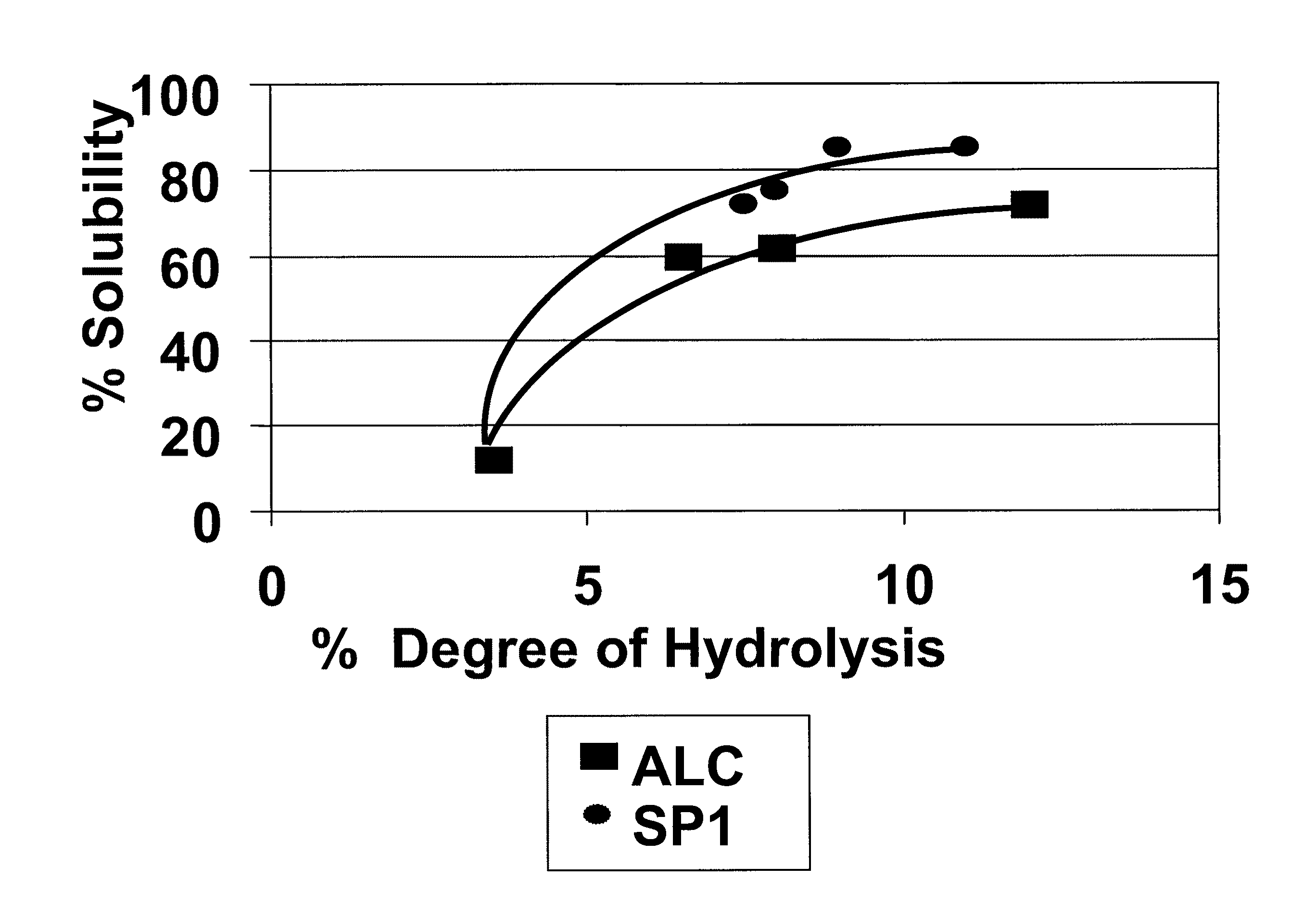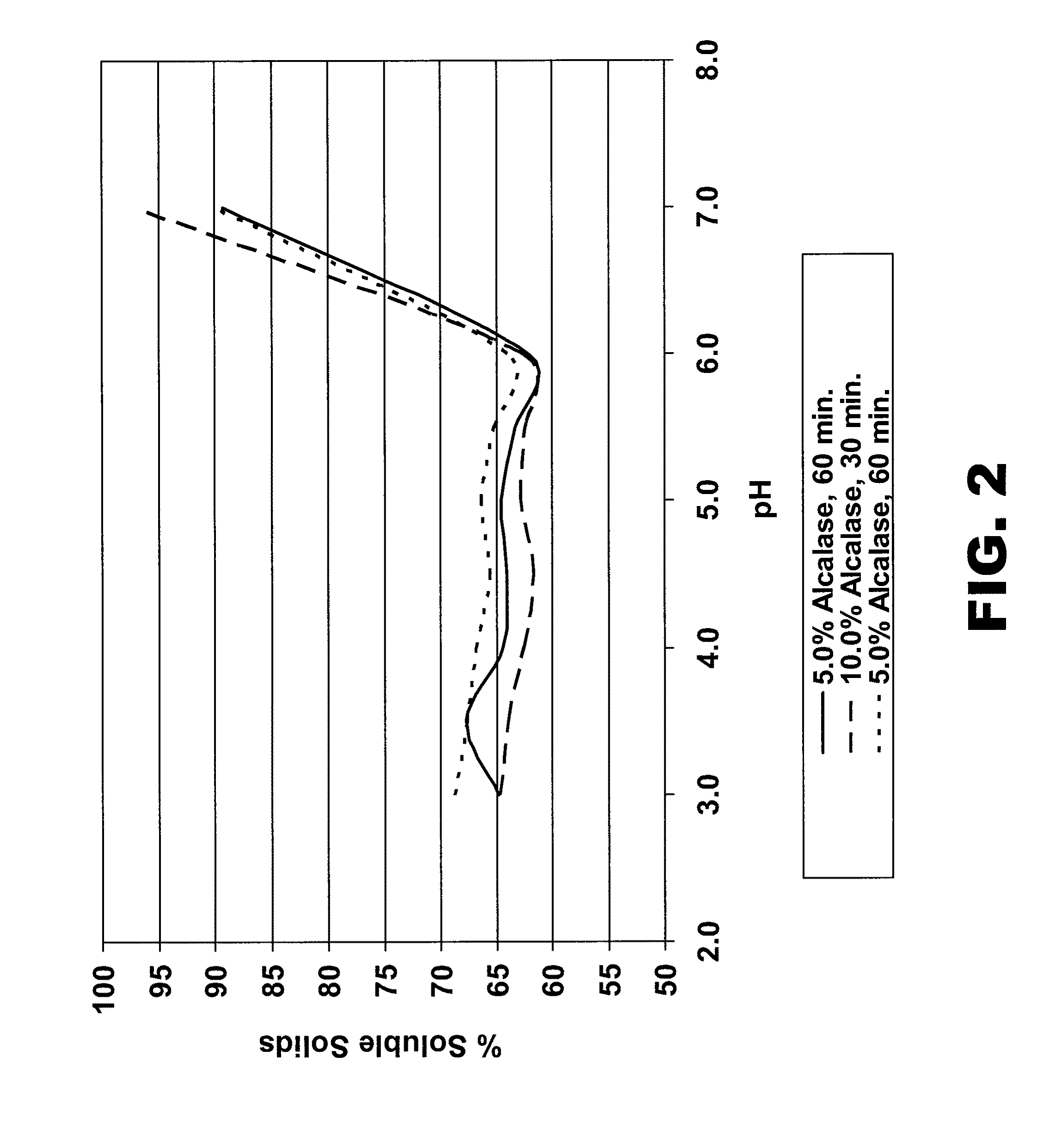Protein Hydrolysate Compositions Stable Under Acidic Conditions
a technology of hydrolysate and composition, applied in the field of protein hydrolysate composition, can solve the problems of fast-paced, harried life style of many individuals, objectionable or unpalatable,
- Summary
- Abstract
- Description
- Claims
- Application Information
AI Technical Summary
Benefits of technology
Problems solved by technology
Method used
Image
Examples
example 1
Hydrolysis of Soy Protein with SP1 or ALCALASE®
[0074]The following study was undertaken to determine whether hydrolysis of soy protein with different endopeptidases could increase the solubility of the hydrolysate at acid pH (i.e., near its isoelectric point)
[0075]Hydrolysis Reactions. The starting material was 10% soy protein isolate (e.g., SUPRO® 500E) suspended in 0.1 M sodium phosphate, pH 8.5. The pH of the protein slurry was adjusted to 8.0 with HCl. The protein slurry was heated to about 70° C. and the mixture was hydrolyzed with either serine protease (SP1) from Nocardiopsis prasina or subtilisin (ALCALASE®) from Bacillus licheniformis. Each endopeptidase was used at a concentration of 19.5 mg, 39.0 mg, 78.1 mg, 156.3 mg, or 312.5 mg of protease per kg of soy protein isolate. The hydrolysis reaction was allowed to proceed at 70° C. for 120 minutes. The reaction was stopped with the addition of 1 M sodium formate, pH 3.7, such that the pH of the mixture was about 4.0 and the ...
example 2
SQS and Bitterness Analysis of SP1 and ALCALASE® Hydrolysates
[0080]The flavor profile of SP1 hydrolysates was compared to that of ALCALASE® hydrolysates. The two preparations were tested with respect to bitterness using the Solae Qualitative Screening (SQS) test. Hydrolysates were prepared essentially as described in Example 1, except that only one concentration of endopeptidase was used (i.e., 300 mg of protease / kg of soy) and the reaction was carried out at 60° C. for 120 min. The enzymes were inactivated by heating the hydrolysates to 85° C. for 15 min. The degree of hydrolysis and percent of soluble solids were determined essentially as described in Example 1.
[0081]Table 3 presents the degree of hydrolysis and % soluble solids (SSI) for each hydrolysate.
TABLE 3Properties of Hydrolysates.Sample% DHSSI %ALCALASE ® Hydrolysate11.4%74%SP1 Hydrolysate11.6%86%
[0082]The SQS method is based upon a direct comparison between a test sample and a control sample, and it provides both qualita...
example 3
Yield of SP1 and ALCALASE® Hydrolysates
[0087]Soy protein was hydrolyzed with either SP1 or ALCALASE® (ALC) (expressed as % enzyme protein) essentially as described in Example 1. The hydrolysis reactions were conducted at pH 8.0-8.5, at 60° C., for 30-60 min. The percent of soluble solids was determined essentially by the percent solids of the soluble over the whole fractions. Yield was calculated as the protein material concentration at the isoelectric point of pH 4.5. Yield is defined as a ratio of the percent of total solids to be centrifuged vs. percent of the solids in the soluble fraction after centrifugation.
[0088]The degree of hydrolysis was determined using a simplified trinitrobenzenesulfonic acid (TNBS) method (i.e., based on that of Adler-Nissen, 1979, J. Agric. Food Chem. 27(6):1256-1262). For this, 0.1 g of the soy protein hydrolysate was dissolved in 100 mL of 0.025 N NaOH. An aliquot (2.0 mL) of the hydrolysate solution was mixed with 8 mL of 0.05 M sodium borate buff...
PUM
| Property | Measurement | Unit |
|---|---|---|
| pH | aaaaa | aaaaa |
| temperature | aaaaa | aaaaa |
| pH | aaaaa | aaaaa |
Abstract
Description
Claims
Application Information
 Login to View More
Login to View More - R&D
- Intellectual Property
- Life Sciences
- Materials
- Tech Scout
- Unparalleled Data Quality
- Higher Quality Content
- 60% Fewer Hallucinations
Browse by: Latest US Patents, China's latest patents, Technical Efficacy Thesaurus, Application Domain, Technology Topic, Popular Technical Reports.
© 2025 PatSnap. All rights reserved.Legal|Privacy policy|Modern Slavery Act Transparency Statement|Sitemap|About US| Contact US: help@patsnap.com



